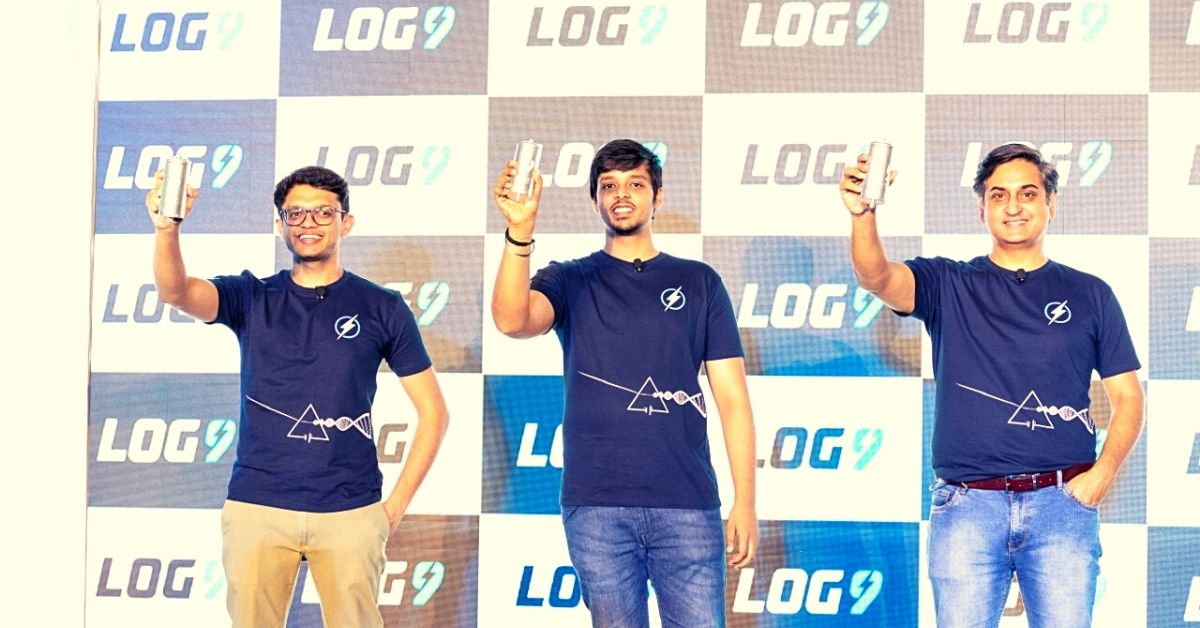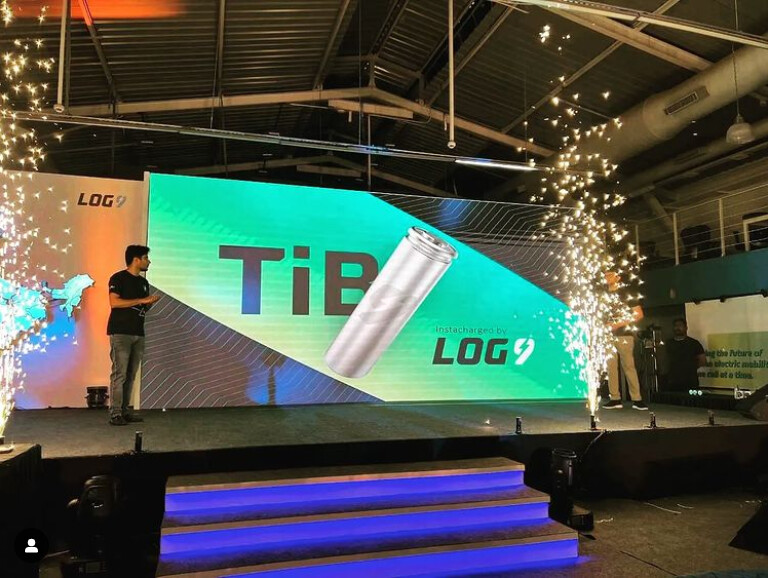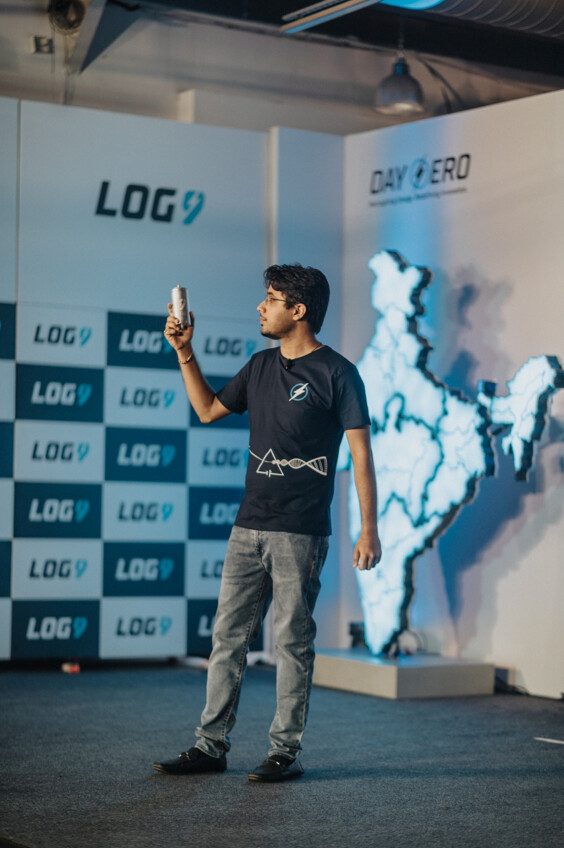Startup’s ‘Made-in-India’ Li-Ion Battery Cells for EVs Can End Foreign Imports
In the first step towards making India self-reliant in meeting its future electric mobility goals, Bengaluru-based deep-technology startup Log9 Materials unveiled India’s first indigenously-developed cell manufacturing facility.

In a very significant development for the electric mobility sector in India, Log9 Materials, an advanced battery-technology and deep-technology startup unveiled India’s first indigenously-developed cell manufacturing facility at their campus in Jakkuru, Bengaluru, on 21 April 2022. The day also marked the venture’s 7th anniversary since its inception.
Why is it such a significant development? Today, a majority of the cells and batteries used in India’s electric vehicles (EVs) are imported from other parts of the world like China and the European Union. This has two adverse consequences for e-mobility in India. One, our lofty e-mobility adoption goals are being held hostage to other countries, not to mention how it impacts India’s trade deficit. Two, these batteries and especially the cells used in them aren’t designed for Indian operating conditions which are quite evident from recent fires and accidents.
Speaking at the unveiling, Pankaj Sharma, co-founder, said, “We are currently working with 11 original equipment manufacturers (OEMs) across different vehicle segments including 2Ws, 3Ws, 4Ws, trucks and buses. We are offering them battery solutions (essentially RapidX battery packs powered by InstaCharge technology) that will enable them to charge EVs 9 times faster and within 15 minutes, which is faster than the time it takes to charge your mobile phone. At the same time our batteries last 9 times longer and offer you performance and reliability which is 9 times higher than your conventional Li-ion batteries as well, not to mention that they can also withstand extreme climatic conditions (-45 to 60 degrees Celsius).”
Christened as ‘Day Zero’ in reference to the starting point of a potentially game-changing transformation in India’s EV sector, Pankaj also noted that their facility “is going to be Southeast Asia’s largest cell production line”. With this new facility, Log9 is aiming to achieve at least 50MWh of peak cell production capacity in the next year, and then they would be scaling to over 5GWh in the next 3-5 years.
Kartik Hajela, Co-Founder and COO, Log9 Materials, added, “When we at Log9 started our journey, we could have either borrowed from what was present in the market and further built on it; but we instead chose to work on a blank canvas, and over the years, with multiple trials, errors and failures, we have been able to better our product and technologies. And today, with utmost pride, we can announce that we have finally made our mark by bringing to India, the best battery and cell technology available. India as a market demands products designed bespoke for the country and not carried forward from some other market.”
Meanwhile, co-founder and CEO, Dr Akshay Singhal, said, “Our cells have been designed from the ground up in India. This means that Log9’s cells and batteries are best suited for Indian operating conditions, climate and customers, and hence they are going to play a crucial role in making India self-reliant while helping the nation realise its ambitious electric mobility vision.”

Choosing Battery Cell Chemistry
Their state of the art indigenous cell production line for battery production is “completely versatile and adaptable to any chemistry or form factor,” notes Dr Singhal.
“India has very different requirements in terms of its climatic conditions, types of vehicles and the way we use them. Until now, we borrowed technology from the West and without applying our minds copy-pasted it into our vehicles not taking into consideration local conditions. When imported components don’t work, we complain about safety, reliability and performance issues. What we built for India today is not going to remain here. The same challenges and problems are being faced by countries across the world’s tropical belt. The problem is those leading battery innovators don’t even have the motivation to sell to us (India), and forget about customising or building solutions ground up. We need to be self-reliant,” he claims.
Critical to the process of manufacturing Li-ion battery cells for India’s largely tropical climatic conditions is the choice of cell chemistry. Log9 is launching its tropicalised-ion battery (TiB) backed by lithium Ferro-phosphate (LFP) and lithium-titanium-oxide (LTO) battery chemistries.
“We have to be conscious about the kind of cell chemistry we are choosing for building India’s self-reliance in energy storage. LTO is not only temperature resilient, but also has a very long life and is robust. Another important aspect to consider when choosing cell chemistry is the availability of materials,” says Dr Singhal. “Which materials can lead to better self-reliance from India’s perspective? What natural resources are available in this regard?”
Speaking at the event, Hemant Charaya, VP of battery cell technology at Log9, said, “We don’t have the requisite lithium reserves that are required for all three cell chemistries. With regards to NMC, we don’t have nickel or cobalt reserves available in India. When it comes to LFP, we have huge reserves of rock phosphorus, graphite, copper, iron and aluminium. When it comes to LTO, we have titanium, aluminium and huge reserves of manganese that can go into the cathode.”
“However, it’s still an uphill task to make sure we get these materials in battery grade. While Log9 is working with academic institutions like IIT-Bombay, IIT-Delhi and IISc-Bangalore to develop these material processes and upgrade these materials to battery grade, we must have that choice of natural resources. Our TiB batteries can work resiliently in tropical climatic conditions and can be built with materials available in India. With this, we have chosen to progress technology advancement in LFP and LTO cell chemistries,” says Dr Singhal.
“With LTO, you get a chemistry or solution which has a longer life and offers rapid charging. When you progress with LFP technology, you obtain the solution for cost efficiency and long-range. Backed with the combination of these two cell chemistries, we can solve all the requirements that we have whether it’s electric mobility, energy storage or any other battery applications even including space research and exploration,” explains Hemant.

Battery Cell Interventions
Besides safety and reliability, LTO also has the longest life among cell chemistries and the highest power density, hence its rapid charging capabilities. But it does have limitations on the cost side and energy density side. LTO might suffer from a higher upfront cost but offers longer life. Thus, the running cost or the total cost of ownership could be far lower. LFP, meanwhile, is the common man’s cell chemistry but suffers a slight shortfall in power density.
The target for TiB-LTO battery cells is to improve their energy density from ~75 Wh/kg (Watt-hour per kilogram) to ~132 Wh/kg (Watt-hour per kilogram). That would make it worthwhile for any kind of intra-city mobility application and all sorts of energy storage applications, notes Hemant.
“Our first intervention here is to shift to a low cobalt cathode. Inside the LTO battery cell, there is a low-voltage anode which we have combined with a high-voltage cathode. Given the massive supply chain issues and unavailability of cobalt-based materials domestically, we have 0% cobalt in our cathodes and shift to manganese-rich chemistries. This will boost our voltage a bit and increase energy density by about 10%. The third intervention we are going for is shifting to a zero-strain and high capacity anode called XNO Anode and that way we can increase the energy density by about 48%. Combined with other factors, we can increase the energy density by a total of 76%, which will offer a massive boost to this technology,” explains Hemant.
“With energy density improvements, we get cost benefits and self-reliance at the same time. As we move to this kind of energy density improvement, we are looking at a 7% reduction in price ($/kWh) from our intervention on low cobalt-rich cathodes, a further 32% reduction with manganese-rich cathodes coming in and another 15% reduction thanks to the intervention on the anode side. All together, we will have more than a 40% reduction in upfront cost of LTO technology thanks to our work. When you talk about LTO, all everyone asks is how you make it cheaper. We have developed this roadmap to make it economically viable,” adds Singhal.
To advance LFP technology, Log9 is looking to switch from smaller format LFP cells to larger format ones, which automatically improves energy density by 5% because you have less dead weight in the system. “We improve the cathode by doping it with suitable elements so you can further improve the energy capacity of the cathode, leading to a 15% increase in energy density. Finally, we incorporate silicon-rich anodes to further improve the energy density of the entire cell chemistry. Overall, we are looking at a benefit of around 27% increase on the energy density side from ~165 Wh/kg to ~210 Wh/kg,” says Hemant.
But it’s not merely about advancing chemical formulation. It’s also about looking at the right choice of cell design, format, and processing techniques. There are typically three types of cell formats — cylindrical, pouch and prismatic. There are many benefits to the cylindrical format including 50% lesser material waste, 20% higher pressure resilience, 10% higher throughput and 6% lower cost as compared to the other two form factors, notes Singhal
“This cylindrical form factor has been available for most of our lives. We have seen it on Duracell cells. Over the years because of improvements in technology, and more automation on the cylindrical form factor, you have less wastage of material by almost 50% when you’re fabricating a cell. This form factor is intrinsically suited to withstand pressure. In Indian conditions, where temperatures are higher, this form factor will offer resilience to hold that structure and shape as compared to the pouch and prismatic cells. These cells won’t deform over time. Given the high throughput of this form factor, there is 6% lower cost in large scale production,” he says.
But a lot of energy can be stored in prismatic cells because the casing is bigger and makers can use thicker electrodes to hold that capacity in. When you take the cells and make a battery pack, there is more efficiency and energy density available in the prismatic form.
“We have overcome these shortcomings in the cylindrical form factor by introducing India’s first Tabless Technology, which will enable us to create high capacity cells with all the other benefits of the cylindrical format. This will lead to better power, energy and still provide resilience and high throughput on the production side. What we are talking about here is 20 times more energy packed into one single cell as compared to conventional smaller format LFP cells and at the same time 24 times more power packed into the same cell. That’s the reason Log9 has chosen to progress the cylindrical format for our cell chemistries,” explains Hemant.
Meanwhile, the lesser number of cells in your battery pack ensures low cell to cell variability at the battery pack level. This results in battery packs with greater reliability and longer life and at the same time ensures that the manufacturing becomes simpler and more cost-effective. In total, Log9 intends to decrease the cost of Li-ion cells on the LTO side by 60% and LFP by 35%.
Sourcing Lithium and Vision
How is Log9 solving for Lithium availability? There is a startup from their alma mater IIT-Roorkee which has come up with a new process to reduce the capital and operational expenditure of lithium recycling and improve efficiency.
“Called Metastable, it’s a company pioneering in lithium recycling with a patented technology that enables more than 90% material recovery from Li-ion cells, reduces the capex of the process by 60% and improves opex by more than 40%. This is a big step in realising our self-reliance from a Li-ion technology perspective because we don’t have to depend on lithium reserves outside India. Today, we have enough old Li-ion batteries roaming around in our ecosystem for 50% of all our EV demand. There is massive potential for urban mining and India can become a hub for lithium recycling to take care of our local needs,” says Singhal.
Meanwhile, Log 9 has already installed the Li-ion cells made in their facility into the inGO Electric scooter. Everything about this scooter was Made in India except for the battery cell which they had to import. The last missing piece of the puzzle is now with INGO Electric.
Speaking at the event, Dr K Sivan, Ex-Chairperson, ISRO, drew a parallel between ISRO founder Dr Vikram Sarabhai’s vision with Log9’s vision for the future.

“Just as Dr Sarabhai many years back understood and laid emphasis on indigenous innovation to advance and reap large scale benefits of space-tech, similarly Log9’s pathbreaking indigenous research and infrastructure development shall bring India closer to self-reliance in energy storage and EV sectors soon,” said Dr K Sivan.
He further added, “I am confident that indigenously produced cells and batteries in India pioneered by Log9 and backed by innovative technology and cell chemistry and high energy density will not only make India proud and self-reliant but also in the long run create history for India and the entire world. I believe that with Indian companies like Log9 taking the lead and showing the way forward for disruption and innovation in our country, the day is not very far when even foreign giant companies like Tesla would be procuring cells from us!”
(Edited by Yoshita Rao)
Like this story? Or have something to share? Write to us: [email protected], or connect with us on Facebook and Twitter.
If you found our stories insightful, informative, or even just enjoyable, we invite you to consider making a voluntary payment to support the work we do at The Better India. Your contribution helps us continue producing quality content that educates, inspires, and drives positive change.
Choose one of the payment options below for your contribution-
By paying for the stories you value, you directly contribute to sustaining our efforts focused on making a difference in the world. Together, let’s ensure that impactful stories continue to be told and shared, enriching lives and communities alike.
Thank you for your support. Here are some frequently asked questions you might find helpful to know why you are contributing?


This story made me
-
97
-
121
-
89
-
167











